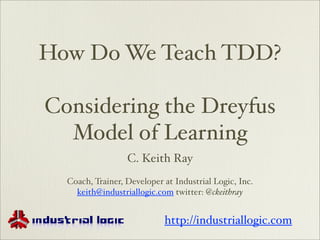
How Do We Teach TDD Keith Ray
- 1. How Do We Teach TDD? Considering the Dreyfus Model of Learning C. Keith Ray Coach, Trainer, Developer at Industrial Logic, Inc. keith@industriallogic.com twitter: @ckeithray http://industriallogic.com
- 2. What's TDD? TDD is Test-Driven Development. The simple description of TDD is: Red-Green-Refactor-Repeat: write a test that fails (red), write just enough code to make it pass (green), then refactor to a good design (aka "simple code"), and repeat.
- 3. Dreyfus Model Dreyfus came up with a model of learning. He named five levels: Novice Advanced Beginner Competent Proficient Expert See http://en.wikipedia.org/wiki/Dreyfus_model_of_skill_acquisition
- 4. Novice Completely new to the thing to be learned. Wants recipes, rules, constraints They don't know what "good" look likes yet, so they want fast feedback. Craves rules.
- 5. Advanced beginner Knows the rules, but not all the contexts for them, knows just enough to be "dangerous." As a software developer, probably writing "big balls of mud". Better to have them learning in a safe environment to learn from their mistakes. 5
- 6. Competent Can do a task without needing instructions. Identifies patterns and uses them, mostly in appropriate contexts. May be offended if you treat them like a Novice or Advanced Beginner.
- 7. Proficient Good, but now trying to become expert. Lots of experience / practice. Knows how to do stuff, but can't tell people how to do it. (Teaching has its own Novice to Expert levels)
- 8. Expert Beyond rules. Working on instinct. Needs to compare notes with other experts. Arguing about their subject refines their understanding of it.
- 9. TDD seems so simple, so why is it hard to teach? Teacher: it's red, green, refactor, repeat. <long time later> Student: ok, here's all my tests! Teacher: where's the code? Student: I haven't written it yet. Teacher: Photo by striatic
- 10. TDD seems so simple, so why is it hard to teach? Teacher: it's red, green, refactor, repeat. <long time later> Student: here's my first test. [400 lines of code in a single test.] Photo by Marcin Wichary
- 11. TDD seems so simple, so why is it hard to teach? Teacher: it's red, green, refactor, repeat. Student: <Doesn't understand why the test should fail before it is made to pass, so writes code and tests so that the tests usually pass the first time they are run.> oops
- 12. TDD seems so simple, so why is it hard to teach? Teacher: it's red, green, refactor, repeat. Student: here's my tests and code. Teacher: nice, but you've got a very large class, with a very large method, and all your tests are repeating lots of code. Did you refactor? Student: I thought we'd refactor next month!
- 13. TDD seems so simple, so why is it hard to teach? Because each of the steps of TDD require skills in three main areas: Writing tests. Writing simple code. Refactoring.
- 14. There's more, Refactoring Requires: Recognizing symptoms of bad design (code smells). Making small transformations to improve the design. (The actual Refactorings.) Recognizing good design (aka "Simple Code")
- 15. "Simple Design" Kent Beck's rules for simple design were: 1. Runs all the tests. 2.No duplication. 3. Expresses the developer's intentions. 4.Minimizes the number of classes and methods. Photo by GN
- 16. Getting back to Dreyfus... We teach using web-base materials in live training and via coaching. Our web-based materials assume the student is in the Novice stage of learning about TDD. We also assume the student is at least in the Competent stage as a programmer. We encourage pairing of students — it makes a large improvement in learning.
- 17. What Novices Want A "novice" is completely new to a subject. They want rules, recipes, formulas, step-by-step how-to-do-it. They don't know enough to judge their own results, so they need fast, frequent feedback by coach or trainer. Photo by Steve Snodgrass
- 18. Breaking TDD Skill-Sets into Novice-sized Pieces
- 19. Demo Video Videos are usually short (around 5 minutes) and demonstrate a technique or make a point.
- 20. Demo Quizzes We have a variety of quiz types. Students can comment on quiz answers or post questions and get a prompt response from Industrial Logic staff.
- 21. Demo: Exercises TDDing Big Bill's Billing System Task 1: Calculate A Simple Phone Bill Task 2: Calculate Excess Minutes Task 3: etc. Student writes the code, compares it with solution(s). Almost all solutions are demonstrated in video form and downloadable code.
- 22. Demo: Critiques Your score was 62% based on our Automated Critique. This ranks you as Intermediate. A Graph of Your TDD Activity See several examples here.
- 23. Conclusion Our web-based training with critiques provides feedback that Novices and Advanced Beginners need, and which would otherwise require one-to-one coaching. This works for our live training as well as purely web-based training. Try it out: http://elearning.industriallogic.com (PS: Competent, Proficient, and TDD Experts should try Sessions.) See also Dan North appling the Dreyfus model to a more general level of "best practices": http://www.infoq.com/articles/better-best-practices
